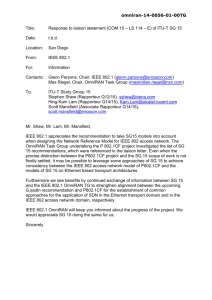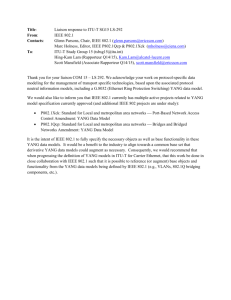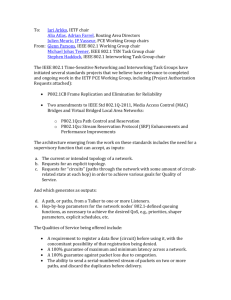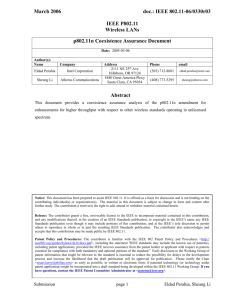Radiocommunication Study Groups
advertisement
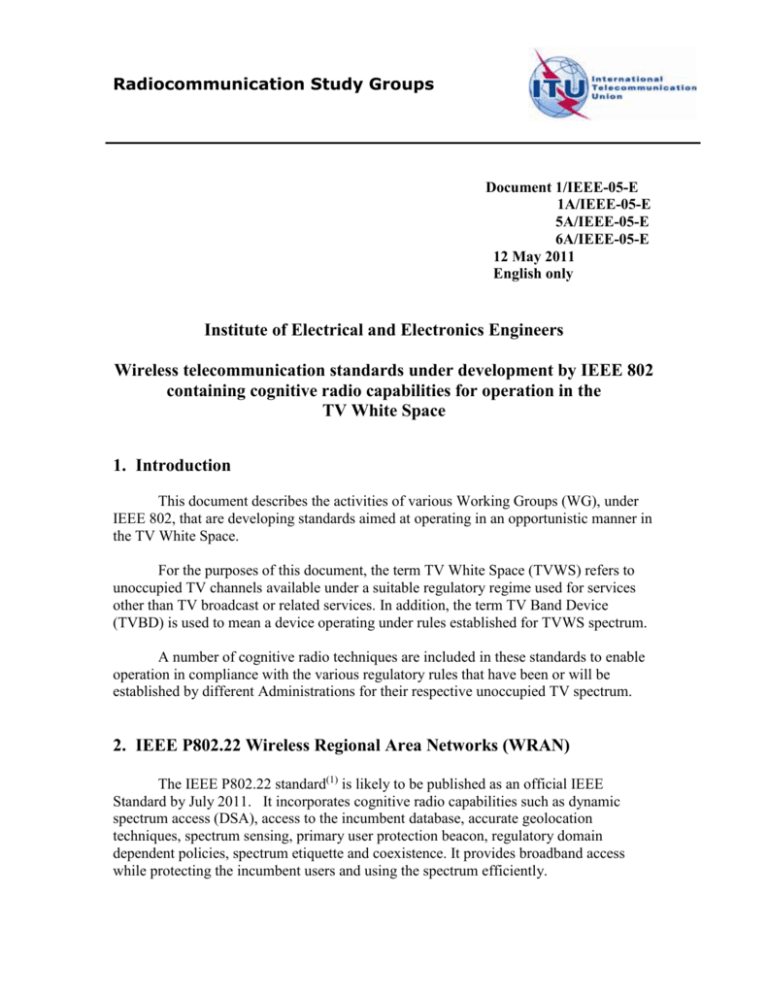
Radiocommunication Study Groups Document 1/IEEE-05-E 1A/IEEE-05-E 5A/IEEE-05-E 6A/IEEE-05-E 12 May 2011 English only Institute of Electrical and Electronics Engineers Wireless telecommunication standards under development by IEEE 802 containing cognitive radio capabilities for operation in the TV White Space 1. Introduction This document describes the activities of various Working Groups (WG), under IEEE 802, that are developing standards aimed at operating in an opportunistic manner in the TV White Space. For the purposes of this document, the term TV White Space (TVWS) refers to unoccupied TV channels available under a suitable regulatory regime used for services other than TV broadcast or related services. In addition, the term TV Band Device (TVBD) is used to mean a device operating under rules established for TVWS spectrum. A number of cognitive radio techniques are included in these standards to enable operation in compliance with the various regulatory rules that have been or will be established by different Administrations for their respective unoccupied TV spectrum. 2. IEEE P802.22 Wireless Regional Area Networks (WRAN) The IEEE P802.22 standard(1) is likely to be published as an official IEEE Standard by July 2011. It incorporates cognitive radio capabilities such as dynamic spectrum access (DSA), access to the incumbent database, accurate geolocation techniques, spectrum sensing, primary user protection beacon, regulatory domain dependent policies, spectrum etiquette and coexistence. It provides broadband access while protecting the incumbent users and using the spectrum efficiently. The P802.22 Working Group started its work in January 2005 following the Notice of Inquiry issued by the United States Federal Communications Commission (FCC)(2) and the first Notice of Proposed Rule Making(3) on unlicensed’ operation in the TV broadcast bands. IEEE P802.22 WG has developed a point-to-multipoint wireless broadband air interface standard optimized for operation in the VHF and UHF TV bands, in the frequency range between 54 MHz and 862 MHz. The standard is aimed at but not limited to serving less densely populated areas (e.g., rural areas) where most empty TV channels can be found and where population is mostly unserved or underserved by Internet broadband access services. The base station (BS) can be accessed by fixed customer premise equipment (CPE) as well as portable devices as per local regulatory requirements. A messaging interface for the purpose of accessing an incumbent database service is included in the standard to accommodate new US regulatory requirements. It should be noted that since the BS controls the DSA in this point-to-multipoint operation, the base station is used as the central point for querying the database service. This is done by acquiring the location of each CPE and portable terminal early in the process of association, querying the database service on behalf of these terminals and locally managing the responses from the database service to decide on the next DSA action for the specific CPE or the entire network. The standard contains mechanisms for the BS to control sensing operations taking place at the CPEs and portable devices, and to report sensing results to the BS. Furthermore, regulatory dependent policies used at the BS to control the DSA behavior under various conditions are embedded in the standard. Satellite and terrestrial geolocation techniques have been incorporated into the standard. Security features have been embedded for cognitive functions as well as the data, control and management functions. Based on the regulatory requirements, certain features, (e.g., sensing) can be disabled if they are not required. Recognizing the difficulty of reliably sensing wireless microphone operations in the TV bands, a parallel standardization activity was undertaken under the P802.22.1 Task Group to develop a related standard for an RF beacon to signal the presence of wireless microphone operation in a more reliable manner. This has resulted in the publication of the IEEE Std 802.22.1™-2010 in November 2010(4). Besides being able to detect broadcast incumbents to avoid interference, a spectrum efficient mechanism is included to detect other IEEE P802.22 WRAN operations to implement self-coexistence. This is achieved by having the available channels properly distributed among WRAN’s operating in the same area and, if needed, distributing frame capacity amongst co-channel operating WRAN systems for more efficient use of the spectrum. IEEE P802.22 cognitive radio-based systems have a potential to provide broadband access to wide regional areas around the world to bring information and communication technologies to unserved and under-served communities. 3. IEEE P802.19 Wireless Coexistence There are several standards projects for wireless networks in the limited TV White Space. In 2009, the IEEE identified potential coexistence issues and as a result initiated a standards project for coexistence of wireless networks in the TV White Space. The IEEE P802.19.1 standards project on “TV White Space Coexistence Methods” was approved by the IEEE standards board in December 2009. The scope and purpose of the project are provided below: Project Scope: The standard specifies radio technology independent methods for coexistence among dissimilar or independently operated TV Band Device (TVBD) networks and dissimilar TV Band Devices. Project Purpose: The purpose of the standard is to enable the family of IEEE 802 Wireless Standards to most effectively use TV White Space by providing standard coexistence methods among dissimilar or independently operated TVBD networks and dissimilar TVBDs. This standard addresses coexistence for IEEE 802 networks and devices and will also be useful for non IEEE 802 networks and TVBDs. The standard will utilize the location awareness and adaptive abilities of the TVBDs, which are capabilities that will be common in the TVBDs. As part of the standards development process, a system design document(5) was developed. The system design document includes a coexistence system architecture that is shown in Figure 1. The architecture consists of three logical entities and five logical interfaces. The logical entities are: Coexistence Manager (CM) Coexistence Enabler (CE) Coexistence Discovery and Information Server (CDIS). 802.19.1 Scope Interface C Coexistence Discovery and Information Server Interface B2 TVWS Database Interface C Coexistence Manager Interface B3 Another Coexistence Manager Interface B1 Coexistence Enabler Interface A TVBD network or device Figure 1 Coexistence system architecture The coexistence system design will provide radio environment awareness to a diverse range of TVBDs using any radio access technology by implementing a distributed, local, geographic database of TVBDs. In addition the coexistence system will offer management services to subscribing TVBDs to implement a standardized spectrum resource allocation among the users of the TVWS. The IEEE P802.19 working group is currently preparing a draft standard. The first draft standard is expected in 2012. The plan is to begin sponsor ballot in early 2013 and for the standard to be published in late 2013. 4. IEEE P802.15 Wireless Personal Area Networks (WPAN) A Study Group (SG) for the IEEE P802.15 Working Group was formed in January 2011 to investigate the potential of IEEE P802.15.4 Low Rate Wireless Personal Area Network (WPAN) operation in the TV White Space. The SG is preparing the Project Authorization Request (PAR) and 5 Criteria (5C) documents. The first drafts of both documents are expected to be ready in July 2011. Recent regulations have allowed unlicensed devices to operate in the TV white space. Operation in the TV White Space is intended for low rate WPAN to deploy large scale device command and control applications with minimal infrastructure. Examples of possible applications include smart metering networks, advanced sensor networks and telemetry systems. This project is needed to make the necessary changes to enable optimal operation of low rate WPAN in the TV White Space. This will be an amendment to IEEE P802.15.4 standard. It addresses principally the P802.15.4 device command and control applications in the TV White Space. It will specify physical (PHY) and medium access control (MAC) amendments to meet regulatory requirements. The amendment will enable operation in the available TV White Space to realize effective device command and control applications. 5. IEEE P802.11 Wireless Local Area Networks (WLAN) The IEEE P802.11af amendment to the P802.11 standard began in January, 2010, as “An amendment that defines modifications to both the 802.11 physical layers (PHY) and the 802.11 Medium Access Control Layer (MAC), to meet the legal requirements for channel access and coexistence in the TV White Space”. The Task Group (TGaf) has been working primarily on understanding the regulatory requirements, where they exist, and defining the amendment to meet the coexistence and non-interference requirements in the various regulatory domains. Basing the initial work on the rules created by the US Federal Communications Commission, in FCC 08-260(6), the project plan targeted the end of 2012 as a completion date. Changes in these regulations in the United States and the efforts to open these bands for unlicensed sharing both in the United Kingdom by Ofcom and in the EU by the Electronic Communications Commission have led to major modifications in the architecture, physical layer selection and security considerations. Currently, the task group is developing the second draft which is expected to receive P802.11 Working Group approval in September, 2011 and will likely be published in late 2013. P802.11af is an amendment to the P802.11 base standard, also known commercially as Wi-Fi™, utilizing an authorized geolocation database for the determination of where, when and how networks may operate. As proposed, or as in the case of the US rules, the database informs the 802.11af network of the channels available to enable the network to find an authorized frequency of operation. The database operation enforces regulatory requirements protecting the operation of licensed devices in its geographical area. It also incorporates mechanisms to operate with other kinds of databases that provide additional time-sensitive information beyond what is currently planned in the FCC regulatory environment. The P802.11af proposed physical layer uses the latest advances in RLAN technology, based on the work being done in IEEE P802.11ac, scaled to the TV channel specifications for license-exempt use, including mechanisms for bonding two contiguous or non-contiguous channels. These advanced protocols are intended to make efficient use of available spectrum to meet the growing demands for streaming of data, voice and compressed multimedia. 6. Conclusion The contribution summarizes the current and future IEEE 802 projects that address new opportunities for spectrum utilization in the TVWS. The information presented here may be of interest to the ITU-R membership. 7. References (1) P802.22-D3, “Standard for Information Technology — Telecommunications and Information Exchange Between Systems — Local and Metropolitan Area Networks – Specific Requirements — Part 22: Cognitive Wireless RAN Mediu Access Control (MAC) and Physical Layer (PHY) Specification: Policies and Procedures for Operation in TV Bands,” March 2011. www.ieee802.org/22 (2) US FCC, ET Docket 02-380: Notice of Inquiry, In the Matter of “Additional Spectrum for Unlicensed Devices Below 900MHz and in the 3GHz Band”, Released December 20, 2002 (3) US FCC, ET Docket 04-186: Notice of Proposed Rule Making, In the Matter of “Unlicensed Operation in the TV Broadcast Bands”, Released May 25, 2004 (4) IEEE Std 802.22.1™-2010, “Standard for Information Technology — Telecommunications and Information Exchange Between Systems — Local and Metropolitan Area Networks – Specific Requirements — Part 22.1: Enhanced Protection for Low-Power, Licensed Devices Operating in Television Broadcast Bands,” November 2009. (5) “System Design Document”, IEEE 802.19-10/55r3, March 2010, available at: https://mentor.ieee.org/802.19/dcn/10/19-10-0055-03-0001-system-designdocument.doc (6) U.S. FCC, ET Docket 08-260, “Second Report and Order and Memorandum Opinion and Order in the Matter of Unlicensed Operation in the TV Broadcast Bands,” November 14, 2008.
